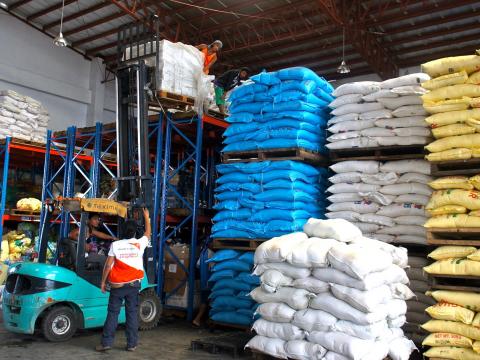Aidworker Diary: The Long Road Ahead

I've been traveling non-stop for three weeks now- as a backpacking aid worker, island-hopping from one disaster zone to another. As we cover more relief areas we are faced with the daunting task of sustaining relief distributions. We're definitely in for a long haul as we address the massive needs of hundreds of thousands affected by typhoon Haiyan.
It's been two weeks now but the devastation lingers like a gaping wound- roadsides are piled up with tons of debris and garbage. Children and families are staying in makeshift dwellings built from whatever scraps they have salvaged. These displaced families grow vulnerable as days pass, with their livelihood ravaged and without a steady source of income they are fully reliant on relief food and emergency supplies.
Right now everything depends on how fast you can reach the disaster zones to deliver aid. Heavy traffic and clogged ports with limited sea barges can easily hamper truckloads of relief supplies from reaching distribution points on time.
It is imperative for the different relief actors to work together with the government along with other partners to establish the humanitarian access needed to sustain the flow of emergency supplies to the disaster-hit communities. Massive challenges lie ahead and we need to ensure that relief operations get the best logistical support available.
The faster we can get more relief trucks to isolated areas the more we can reach out to people who need urgent relief aid.
In Ormoc we were able to obtain the government's assistance in ensuring that there's allocated space for relief workers in the fastcraft ferries. However, this is not enough. We continue to call on our government's support for swift delivery of aid by prioritising relief trucks in sea barges and by making various modes of transportation like C130 planes and choppers accessible for transporting life saving relief supplies to the hardest-hit communities, as well as continuously work on massive road clearing operations to establish stable travel routes. The faster we can get more relief trucks to isolated areas the more we can reach out to people who need urgent relief aid.
On the road, you never know when you'll end up next. I talk to the drivers for directions, travel schedules, food and toilet stops. They've become my friends and valuable allies. The critical information they provide together with the number of water bottles and food supplies we have determine how far we can go.
The road has become my home; I sleep and eat, review my notes and photos, charge my gadgets inside the van while in convoy with the trucks during distributions in northern Cebu.
The next day you're up and running by 4am in the morning as you troop to the sea port and scramble for ferry tickets as you head to Ormoc. In the ferry you see people carrying basic supplies for their loved ones. You spend the ferry ride running through your plan for the next trip- coordinating your itinerary, securing vehicles, packing up food and essential supplies for your whole team. Everyone's safety is a top priority.
Every morning seeing the sunrise along the coasts while driving up amidst the sprawling fields and mountains going to northern Cebu and being welcomed by the beaming faces of children attending Child-friendly spaces is a welcome respite.
Going home after a day's work resource gathering and visiting disaster-affected communities in Ormoc, you head back to the port tired and sleepy and the sunset is smiling at you with its fiery glow as if telling you never to give up.